Nevangary
Hello. This time I would like to touch on the topic of developing computer games, to show some ideas and prototypes. Specifically, this article focuses on projects and sketches inspired by the game Wangers, she Vangers: One For The Road. Stick yourself comfortably, the hold is full of interesting things, the spiral is charged, let's go.
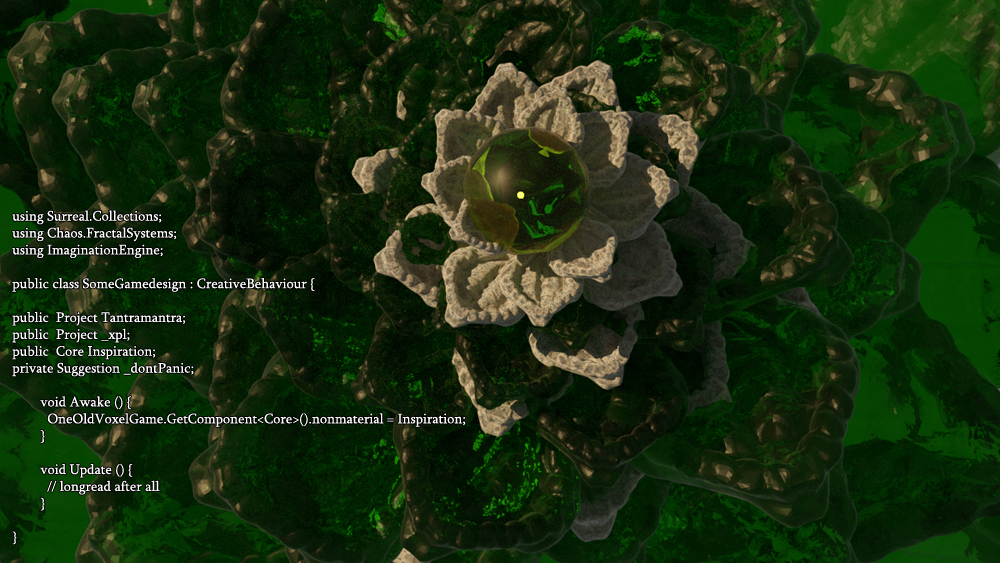
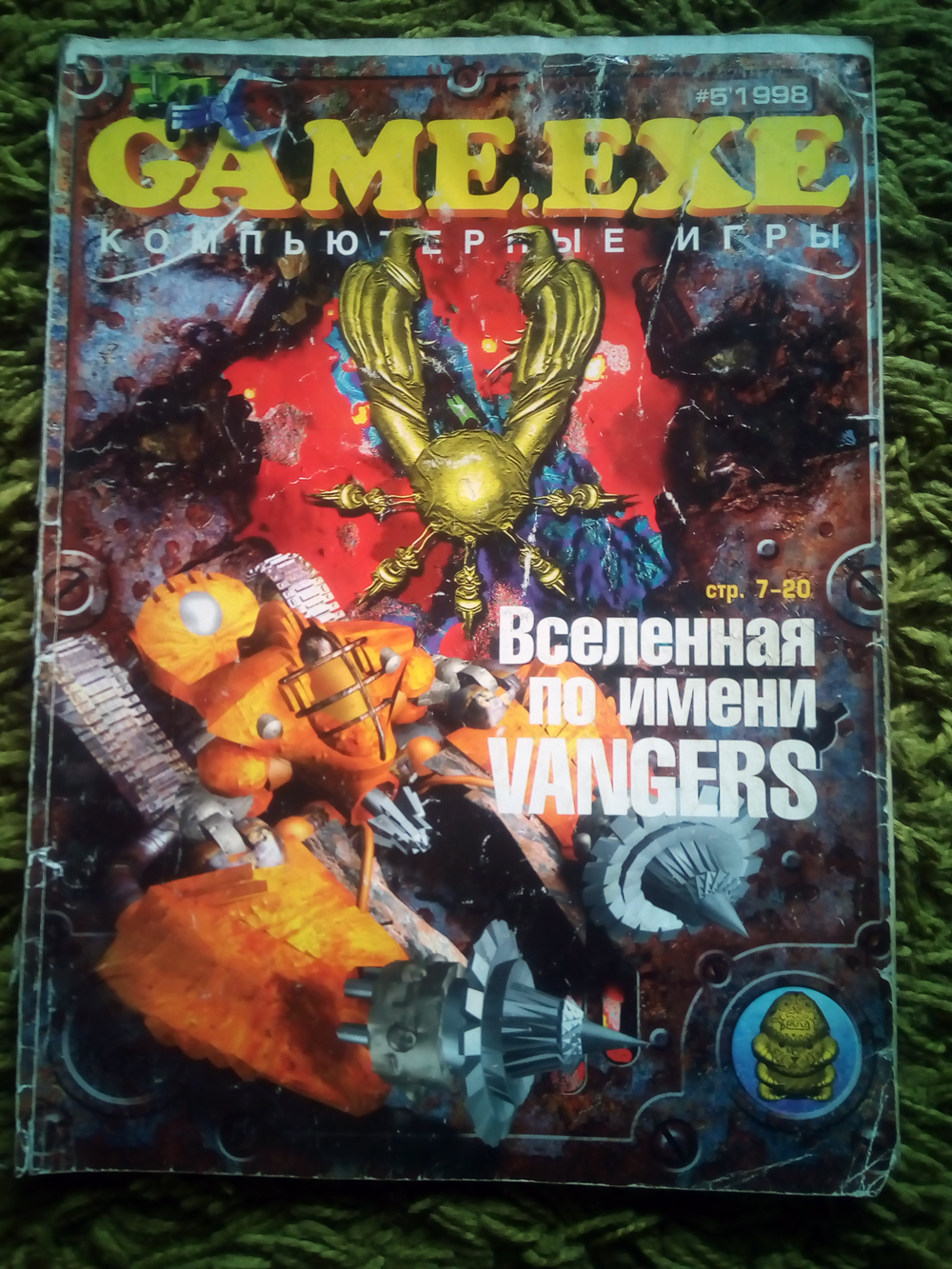
I got acquainted with the original game 20 years ago, after reading that matchless article in the fifth issue of Game.exe for the 98th year, and buying a CD with Wangers before buying my first computer. At that time, Spectrum and eight-bitters were still at home, and at school they only began to allow the gloomy dosu and 95th windows, as well as Diablé, Duke, and the network Warcraft. The truth sometimes had to sacrifice all this consciously. Because QBasic was more interesting.
')
But back to the Vangers. There is a game, but there is no place to play. It does not matter - built a desktop "based on". So we drove through the cells of the machine, transporting goods between the three cities - on curved roads, calmer and faster, and if cut, it is more difficult to move, but you can stumble on caches. The very same PC-disk lay on the shelf, as a kind of talisman and in absentia favorite game. The bonus was that it could be played in a PlayStation One bought a little later, like a music disc.
Console exclusives, it is worth noting, absolutely discouraged my desire to play most of the iconic western games, mostly role-playing, when I got my first computer (well, I had to part with Sonya for that). But Vangers fully met my expectations, being launched for the first time. Because even the final product itself is not as important as the images they, one way or another, are generated.
If you suddenly do not know, then Wangers is a Russian voxel surreal action with cars and a top view. The game could drive, shoot, jump, swim, crush, destroy terrain, blow up mushrooms, find hiding places, trade, rob, completely get lost in the texts and interface, ride again, notice that the destruction of the landscape is saved, complete quests, notice that objects can drop out of inventory to the ground in a dashing bend, make money on a new machine, win a race, visit other worlds, listen to their melodies, lose everything, learn Zen, repeat, repeat in multiplayer.
To get a better idea, you can get acquainted with the video reviews. For example, here with this . Or read in text form .
Not so long ago, the original was reissued in Steam. And the community has a separate telegram channel .
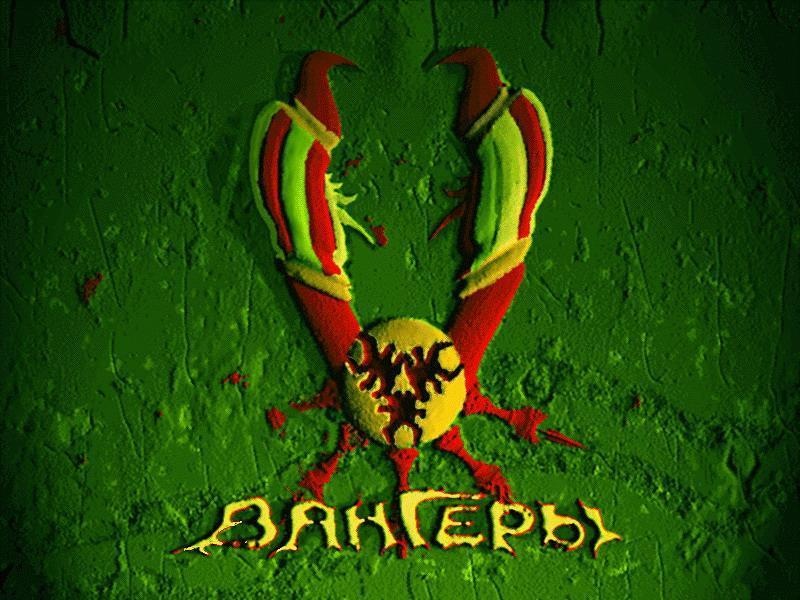


Reprint reissue, but, of course, I waited for the continuation. And, you can say, I received it as a freaky first “Perimeter” (which slightly reminds me of another forgotten gem - Netstorm), but some action projects never followed.
"Mehosome" turned into "Samogonka", a toy pleasant outwardly and conceptually, but some kind of too furious inside and that is sufficiently passable. Nevertheless, such experiments are also useful - they improve the understanding of what is worth mixing with and what is not.
In the process of life, developers migrate between different development environments. So I gradually swam from Spectrum Basic, Qbasic and Delphi, to the bundle of Unity with Blender, passing Flash, and also Blitz3d in harness with 3ds Max.
Blender was impressive before - a full-fledged powerful 3d-package that weighed some miserable tens of megabytes. True, he demanded to get used to it, but it was worth it. At first I didn’t climb deep into his capabilities, basically I liked the opportunity to paint vertices then, and so I got used to using max.
Years passed, I again returned to 3d from the desktop-role development, and no longer considered Max at all, aiming at Blender. Since then, he managed to acquire an “honest” raytracing with a Cycles render, a 3d pencil, a sculpture and other usefulness. This time the interface did not seem to be something cosmic — that first experience might be useful, maybe the environment has really become more intuitive. Meanwhile, version 2.8 promises to be even more interesting - not only the smart "game" render Eevee, but also a modified interface, a boost of animation capabilities. In principle, this is all there is, but so far in unstable builds - let's say I have a 2.8 bit buggy scene and are completely transparent in the communication node editor (but on Linux this version works more stably). In general, Blender is a very good open source.
Unity. Also a great tool. To understand how everything works, the experience of using Blitz3d and Flash came in handy; at the last one I was just collecting finished games, not just prototypes. Thus, in Unity, I found everything I needed to make 3d graphics work on scripts. Although now, in principle, a lot of engines have appeared - it’s not a problem to do anything. Now, the problem is more likely to be optimized, because development environments have become more user-friendly and there is a great temptation to fill all available space with super-heavy super-detailed objects, and to write code as if you are modeling a real situation, head on. Given that the classical approach consisted in the total use of tables, arrays, matrices, a variety of operations with them, and the formation of various illusions for the user - the illusion of volume, the illusion of movement, the illusion of effects, and so on. That gave a good optimization with modest power.

And here I am sitting somehow, I am modeling all sorts of low poly elements in Blender, and I remembered the Wanger machine-mechanics. I sketched one such, well, since Unity is also at hand, then why not ride it. Then, an asset with the wheel physics was discovered by chance, and the thought flashed “not to collect a small piece of the location from Wangers on Unity”. By the way, once upon a time, in Flash I collected a toy, where I had to blow up mushrooms and crush running bugs - also a kind of reference to the moments from Vangers.
Unity-asset, by the way, was called MS Vehicle System (free version), if anyone is interested.
This is how the first prototype appeared, with which a small video was recorded:
It was not clear where to develop further, and I started another game, about a different idea and with control on more standard mechanisms, not through special assets.
In parallel, I tasted Blender more closely, especially a sculptor, and immersed myself in experimenting with the rendering of all sorts of concepts, characters, architecture. During the experiments with the next method of creating models in the head, something clicked and wanted to make such an “organic” machine. It was then that everything began to turn.

Indeed, what if we imagine some kind of continuation of the original game. With new mekhosy, new issues, new engine.

Organic Heretic

Matron
How could the plot of such a continuation look like? It seems to appear something in the spirit of the original. I see it like this:
The continuation of the story covers the events of the Chain of Worlds after the Storm of Gates, during which new Corridors randomly appeared and closed in various places. During the cataclysm, the familiar ties between the worlds collapsed, and other forms of life began to actively penetrate from the new portals. In pursuit of new weapons and artifacts, four-wheeled heroes rushed into the new Corridors to explore other worlds.
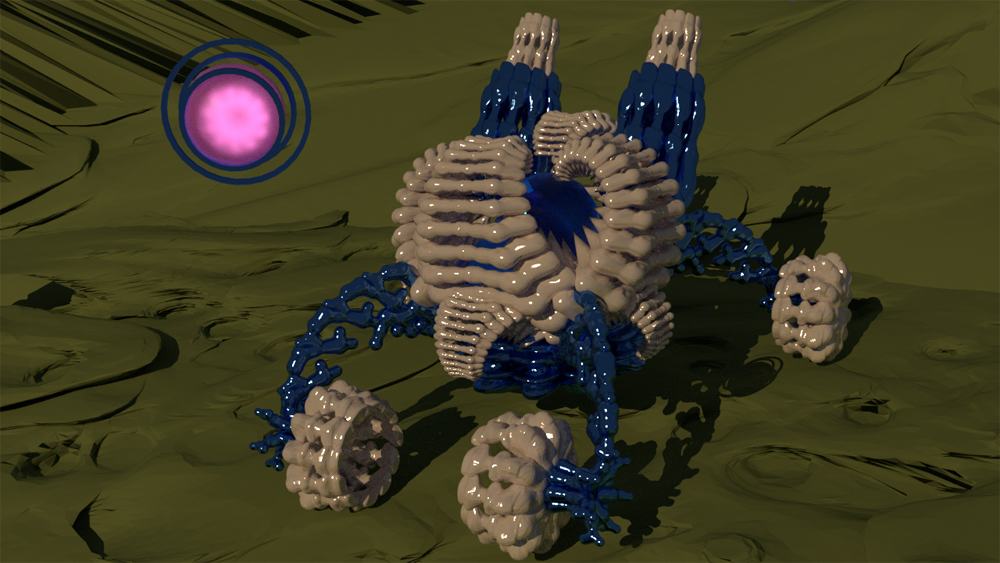
Puppeteer
Time went by. The storm subsided, but random Corridors still arise, and the existing ones are not always stable. New problems have also become apparent - as long as the mokhos have driven along the transitions, restoring connections with the old measurements, some have drifted into very dangerous distant worlds. There, their bodies decayed very quickly, but some managed to survive in an alien environment, merge with it and turn into something else. Over time, these aliens began to go beyond the limits of measurement, more and more often going out on the roads of the Chain and colliding with its other inhabitants. They carry with them strange new abilities and orders, and most of the usual weapons have proved ineffective against these unusual newcomers. And yet, in addition to the proliferation of fauna and flora, the heroes are threatened by a mysterious Roy-Technology - a collection of small artificial creatures with a single mind.

Vicious sister
It is rumored that the Sisters are dragging off parts of the fallen somewhere far away for their secret experiments. Heretics behave more clearly than all the others, they will go for the familiar mekhoz from a distance, take on the usual trade, and advisers welcome them. Puppeteers with their security drones are usually busy with some kind of research, but the Matrons behave quite aggressively.
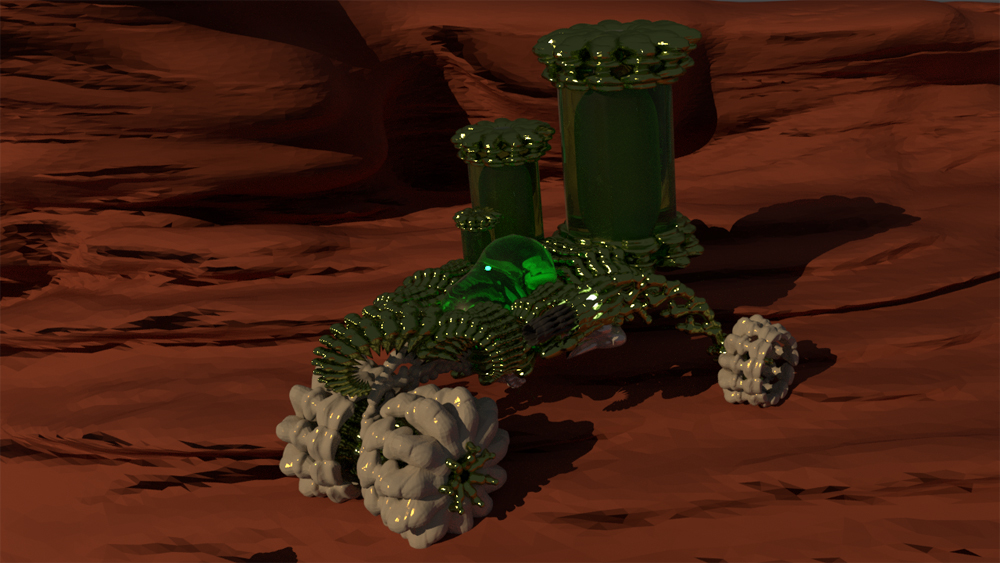
Deeply dependent
In order not to go to the dustbin of history, rusting heroes have to ask for help from the odious inhabitants of exotic worlds - they will share the secret of technology somewhere, they want to get alien samples for experiments, they will replace an iron body kit with a biological one or implant an organic part, somewhere they will print your spare copy on a scam printer, somewhere they will teach you new abilities.

Spiral daughter
Something like this story emerges. Mekhosov came up with a lot, below you can look at the rest:
In addition to the renders themselves for each typewriter recorded a demo mini-clip, where they rotate around its axis. Rendered in Blender 2.79. The point is, of course, not fast, but decided to write in 640 by 480 - it seems to be enough. I made a couple of first animations for 60 frames, then doubling each in a video editor. And then I began to do more smooth, already in 120 frames.
The rest of the mechanic rotate here:
And still modelki can be inserted into the same voxel engine, for all sorts of modding and expansion of basic content. Here is a look at the Heretic, whom tractor tractor flooded through the converter into the game:
On the other hand, there is no need to dwell on the idea of remastering the existing franchise, in the end this is the business of those who have rights to the universe. On the basis of the same concept, you can build a completely new title, with blackjack and bio-mechs.
In the chat of the telegram channel, a question was asked on the topic of the fact that if the mekhoses have a plant-biological nature, what about their guns. So to say, "Does the weapon grow in the garden?" And then I thought, why don't the arms have a foot, and just be a part of the evolutionary chain of the mechos. So the additional concept was thought up:

So, in the beginning we have an embryo that develops into a flying “insect”, then it turns into a weapon with legs. A weapon is a symbiote that attaches to typewriters and allows them to shoot. After some time or after a certain number of owners, it swells and pupates. Then the doll develops and at the end a machine appears from it.
In parallel with inventing concepts, I threw models into Unity to ride. The main current Unity project was not suitable for this. And here again that Nevangerovsk prototype was useful, which already implies wheeled vehicles. Here's what happened:
The Unity prototype itself can be downloaded here . The C button switches cameras (the next after the main, free one can zoom in and out with the wheel), the R button restarts the location (useful, as cars can easily get stuck and can't jump yet), the arrows at the top of the screen switch between the available mechanics (with interactive objects fully interacts only the main).
Demo weighs 65.9 MB, under a 64-bit OS.

Now for the other prototype. He is also in some way inspired by the Wangers. I wanted something strange, with a similar core idea, but not a copy. that is, I wanted to do exactly that “not Wangers”, but something different. With strange worlds, mysterious places, search for unusual gizmos, discoveries and just do some kind of gameplay, not tied to the text. I usually like all sorts of representatives of the "racing" genre, if the process is not overloaded with unnecessary details and realistic surroundings. That is, they attract arcades, not simulators. At the same time, winding exactly cut circles is not the most pleasant thing. I still want to openly explore a certain world. From this and decided to make a start.
So a certain story was drawn up about a cybernetic hero, plowing different worlds in search of the meaning of existence. This hero belongs to a race of race cars with a quantum mind that should look something like futuristic one-wheel bikes.
Inside the car is semi-antigrav, which allows the bike to be weightless, provided that its wheel comes into contact with the body of great mass (the earth's surface).
Started with cubes:

Not really cubes, but you understand
After the first pokatushek some understanding came where all this can be developed. Modelka has become more complicated, some sketches of location have appeared:
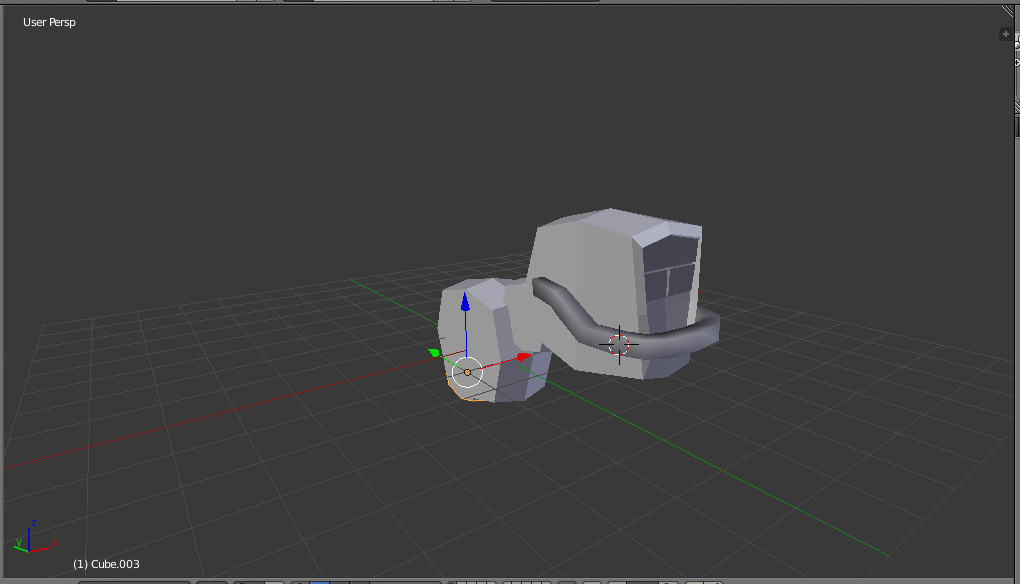
Car 2.0

Starting location
At that time, as a gameplay, a high-speed exploration of the expanses of the abandoned world and solving some of its mysteries was assumed. Although I would not call it a race or a puzzle, but the directions are close. I deliberately ruled out the possibility of “postrelushkas” - this is the simplest thing, that the first thing you do is dragging into any games and then everything degenerates into cannon-shots-ammunition-shooters. Not that this is bad, and maybe shooting will be added in the future, but I would like to see first what comes up with no boevka. With regards to some text plot, some inventory and some other actors - this is all in question. I like the idea of some kind of delivery of goods between different points, but I would not like to introduce it in the form of trade in items.
In the meantime, the first iteration of the idea looked something like this:
A little later, while continuing to comprehend Blender, I got to the high poly modeling and decided to make a more technologically advanced bike model for XPL. Just a model for the renderer to be:



But you understand that you want to immediately add the model to the engine in order to even see it trivially in motion, since rendering simple animation in Cycles is already quite a long time. The problem is only in too many polygons, although modern engines can be fed and not so. However, I want to accurately, beautifully and productively, which is called "according to the classics." The blessing of the model was not a sculptor, besides it was modeled through symmetry, so a full-fledged retopology was not required and the grid optimization went quickly:

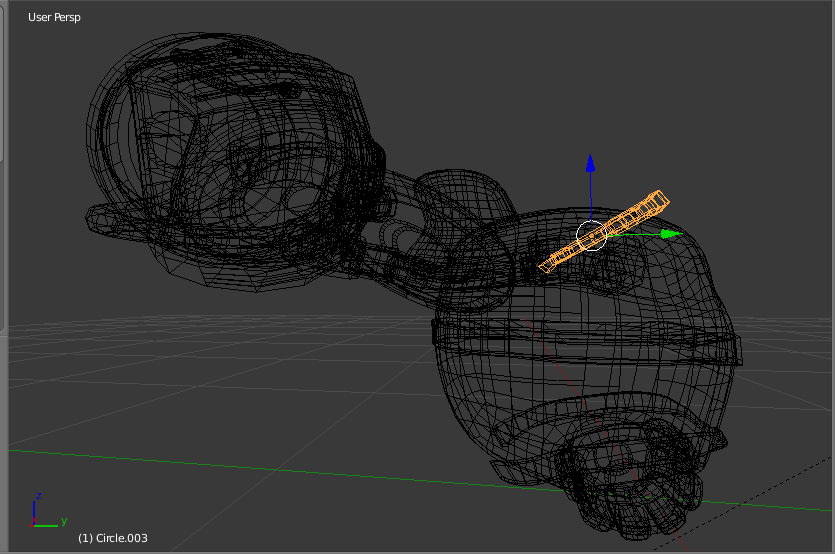
In addition to the new model, I thought about the fact that some levels could have a camera fixed above the hero. So there was a separate scene from the top. True, the control in it no longer worked as it should, because in the original the turns were controlled by the deflection of the mouse from the center and in a different perspective a full ride did not work. Well, it was a signal to the fact that management needs to be changed, at least within the framework of a new scene. As a result, I rewrote the control model and now the car turns to the sides on the side arrows, and up / down goes forward or backward. Along the way, the constituent elements of the character changed, thanks to which he began to ride better and most importantly, he gained the ability to “stick” on the surface without sliding off. I just wanted to achieve this effect, because it is better suited to reflect how the conceived semi-graphite transport should behave. Yes, he now became a real climber.
I liked the new form of control more than the old one, despite the fact that the character controller element has its own nuances and it does not fully participate in physics, as the previous version with rigidbody. Therefore, in the scene with the camera behind the car, I also replaced the controls. After that, he collected the following prototype, demonstrating new elements:
In principle, the shaders system built into Unity allows you to customize materials quite flexibly, but I lacked some more colorful glare effects and I looked for various ways to make them easier. The solution was the matcap concept - in the same Blender there are sets of these simple textures that store the light map of the environment, which replace the materials of the entire scene, look good and are drawn on the fly in real time. They managed to achieve even more juicy-looking model.
Along the way, I took up the location for the top view, reworking it from scratch, drawing paths, mountains and arranging various new elements there:

Since the top is rather difficult to navigate around the surrounding landscape, the mini-map was asked for itself. But this element in Unity is added relatively easily - literally in a few clicks. But another thing that came to my mind required much more time to implement, although here, too, as a result, the code did not turn out much. I mean the automatic zoom, which alienates the main camera when the car accelerates - as in the first GTA. And now, when all this has already worked, then the next one, until the last build, containing all these new changes, followed. Video cutting:
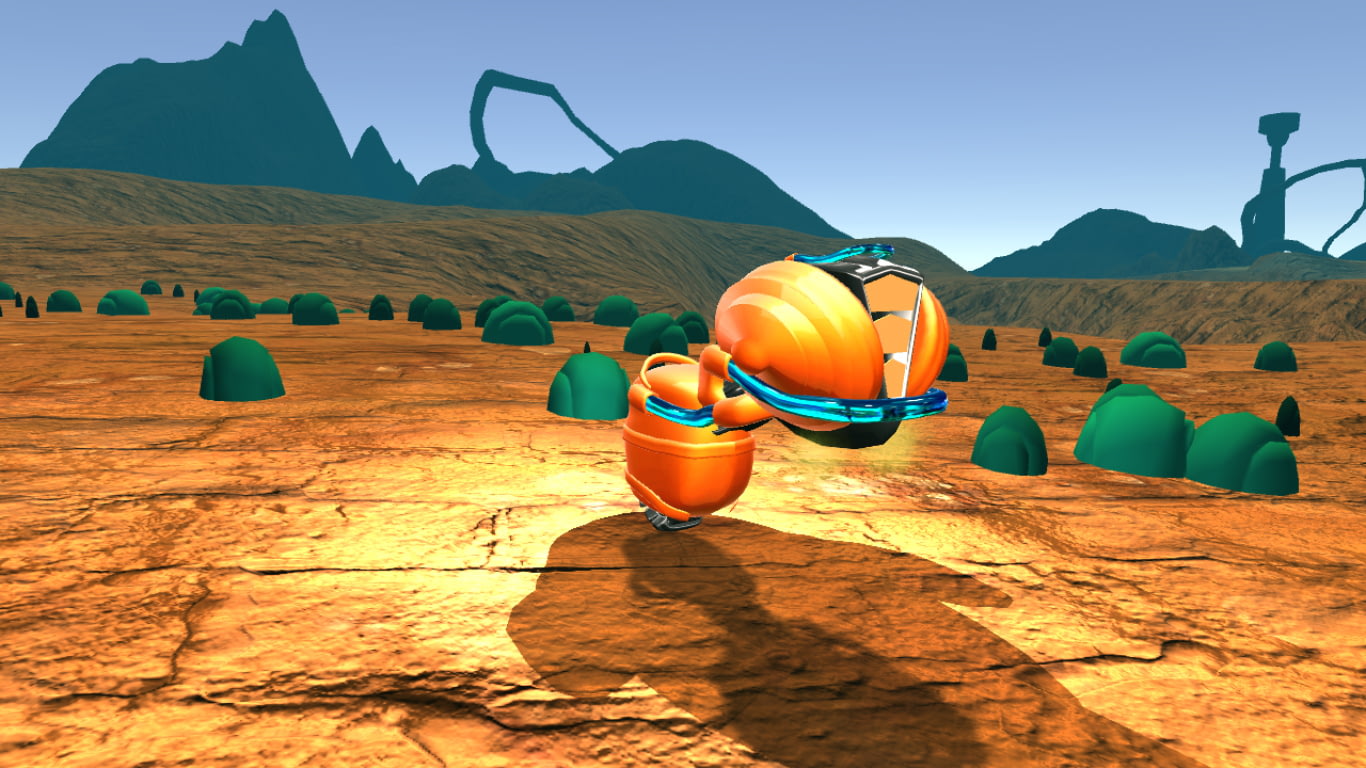
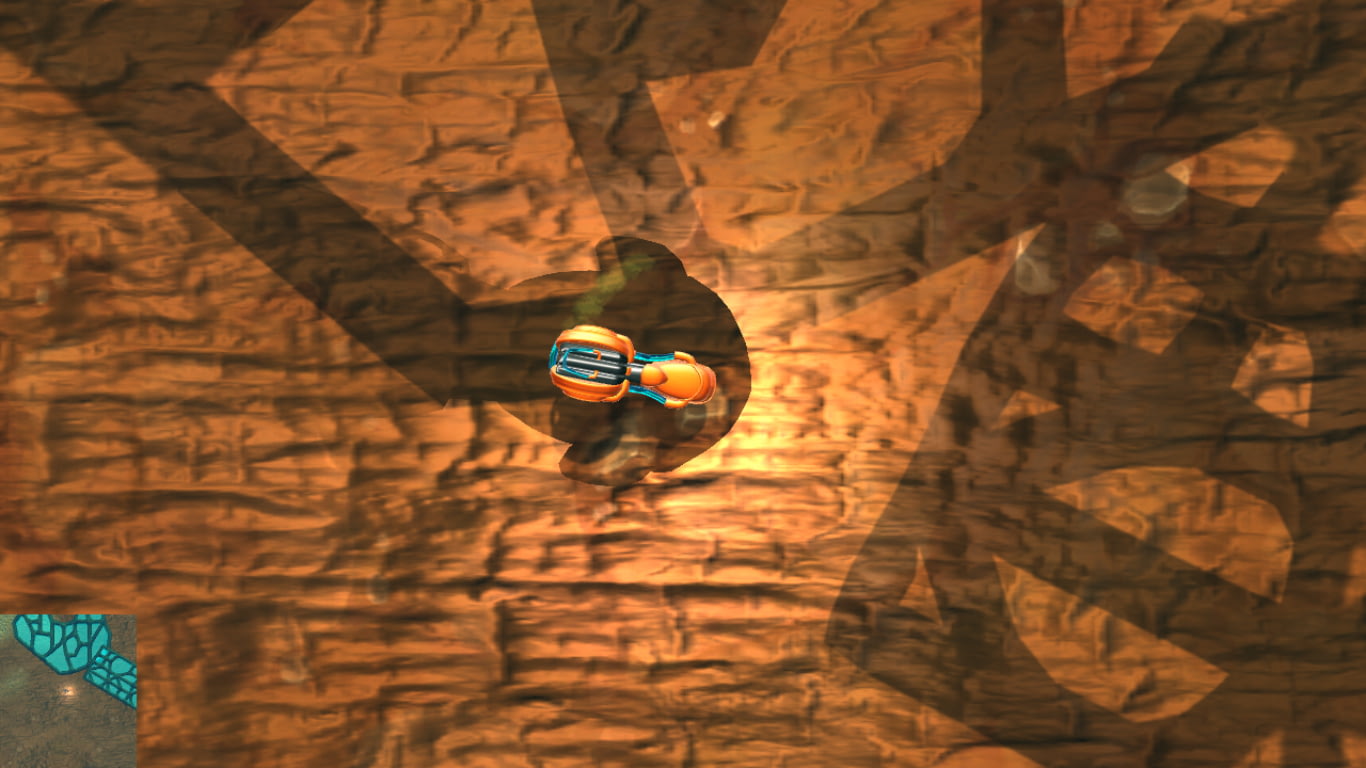
The prototype is posted here . Jump to the gap.
It weighs about 45 MB, version for 64-bit OS.
Well, on this I have so far everything. I hope the trip was pleasant and not tiring.
Good luck with your projects!


I got acquainted with the original game 20 years ago, after reading that matchless article in the fifth issue of Game.exe for the 98th year, and buying a CD with Wangers before buying my first computer. At that time, Spectrum and eight-bitters were still at home, and at school they only began to allow the gloomy dosu and 95th windows, as well as Diablé, Duke, and the network Warcraft. The truth sometimes had to sacrifice all this consciously. Because QBasic was more interesting.
')
But back to the Vangers. There is a game, but there is no place to play. It does not matter - built a desktop "based on". So we drove through the cells of the machine, transporting goods between the three cities - on curved roads, calmer and faster, and if cut, it is more difficult to move, but you can stumble on caches. The very same PC-disk lay on the shelf, as a kind of talisman and in absentia favorite game. The bonus was that it could be played in a PlayStation One bought a little later, like a music disc.
Console exclusives, it is worth noting, absolutely discouraged my desire to play most of the iconic western games, mostly role-playing, when I got my first computer (well, I had to part with Sonya for that). But Vangers fully met my expectations, being launched for the first time. Because even the final product itself is not as important as the images they, one way or another, are generated.
If you suddenly do not know, then Wangers is a Russian voxel surreal action with cars and a top view. The game could drive, shoot, jump, swim, crush, destroy terrain, blow up mushrooms, find hiding places, trade, rob, completely get lost in the texts and interface, ride again, notice that the destruction of the landscape is saved, complete quests, notice that objects can drop out of inventory to the ground in a dashing bend, make money on a new machine, win a race, visit other worlds, listen to their melodies, lose everything, learn Zen, repeat, repeat in multiplayer.
To get a better idea, you can get acquainted with the video reviews. For example, here with this . Or read in text form .
Not so long ago, the original was reissued in Steam. And the community has a separate telegram channel .



Reprint reissue, but, of course, I waited for the continuation. And, you can say, I received it as a freaky first “Perimeter” (which slightly reminds me of another forgotten gem - Netstorm), but some action projects never followed.
"Mehosome" turned into "Samogonka", a toy pleasant outwardly and conceptually, but some kind of too furious inside and that is sufficiently passable. Nevertheless, such experiments are also useful - they improve the understanding of what is worth mixing with and what is not.
Blender and Unity
In the process of life, developers migrate between different development environments. So I gradually swam from Spectrum Basic, Qbasic and Delphi, to the bundle of Unity with Blender, passing Flash, and also Blitz3d in harness with 3ds Max.
Blender was impressive before - a full-fledged powerful 3d-package that weighed some miserable tens of megabytes. True, he demanded to get used to it, but it was worth it. At first I didn’t climb deep into his capabilities, basically I liked the opportunity to paint vertices then, and so I got used to using max.
Years passed, I again returned to 3d from the desktop-role development, and no longer considered Max at all, aiming at Blender. Since then, he managed to acquire an “honest” raytracing with a Cycles render, a 3d pencil, a sculpture and other usefulness. This time the interface did not seem to be something cosmic — that first experience might be useful, maybe the environment has really become more intuitive. Meanwhile, version 2.8 promises to be even more interesting - not only the smart "game" render Eevee, but also a modified interface, a boost of animation capabilities. In principle, this is all there is, but so far in unstable builds - let's say I have a 2.8 bit buggy scene and are completely transparent in the communication node editor (but on Linux this version works more stably). In general, Blender is a very good open source.
Unity. Also a great tool. To understand how everything works, the experience of using Blitz3d and Flash came in handy; at the last one I was just collecting finished games, not just prototypes. Thus, in Unity, I found everything I needed to make 3d graphics work on scripts. Although now, in principle, a lot of engines have appeared - it’s not a problem to do anything. Now, the problem is more likely to be optimized, because development environments have become more user-friendly and there is a great temptation to fill all available space with super-heavy super-detailed objects, and to write code as if you are modeling a real situation, head on. Given that the classical approach consisted in the total use of tables, arrays, matrices, a variety of operations with them, and the formation of various illusions for the user - the illusion of volume, the illusion of movement, the illusion of effects, and so on. That gave a good optimization with modest power.

Nevangary
And here I am sitting somehow, I am modeling all sorts of low poly elements in Blender, and I remembered the Wanger machine-mechanics. I sketched one such, well, since Unity is also at hand, then why not ride it. Then, an asset with the wheel physics was discovered by chance, and the thought flashed “not to collect a small piece of the location from Wangers on Unity”. By the way, once upon a time, in Flash I collected a toy, where I had to blow up mushrooms and crush running bugs - also a kind of reference to the moments from Vangers.
Unity-asset, by the way, was called MS Vehicle System (free version), if anyone is interested.
This is how the first prototype appeared, with which a small video was recorded:
It was not clear where to develop further, and I started another game, about a different idea and with control on more standard mechanisms, not through special assets.
In parallel, I tasted Blender more closely, especially a sculptor, and immersed myself in experimenting with the rendering of all sorts of concepts, characters, architecture. During the experiments with the next method of creating models in the head, something clicked and wanted to make such an “organic” machine. It was then that everything began to turn.

Tantramantra, or Wangers 2
Indeed, what if we imagine some kind of continuation of the original game. With new mekhosy, new issues, new engine.

Organic Heretic

Matron
How could the plot of such a continuation look like? It seems to appear something in the spirit of the original. I see it like this:
The continuation of the story covers the events of the Chain of Worlds after the Storm of Gates, during which new Corridors randomly appeared and closed in various places. During the cataclysm, the familiar ties between the worlds collapsed, and other forms of life began to actively penetrate from the new portals. In pursuit of new weapons and artifacts, four-wheeled heroes rushed into the new Corridors to explore other worlds.

Puppeteer
Time went by. The storm subsided, but random Corridors still arise, and the existing ones are not always stable. New problems have also become apparent - as long as the mokhos have driven along the transitions, restoring connections with the old measurements, some have drifted into very dangerous distant worlds. There, their bodies decayed very quickly, but some managed to survive in an alien environment, merge with it and turn into something else. Over time, these aliens began to go beyond the limits of measurement, more and more often going out on the roads of the Chain and colliding with its other inhabitants. They carry with them strange new abilities and orders, and most of the usual weapons have proved ineffective against these unusual newcomers. And yet, in addition to the proliferation of fauna and flora, the heroes are threatened by a mysterious Roy-Technology - a collection of small artificial creatures with a single mind.

Vicious sister
It is rumored that the Sisters are dragging off parts of the fallen somewhere far away for their secret experiments. Heretics behave more clearly than all the others, they will go for the familiar mekhoz from a distance, take on the usual trade, and advisers welcome them. Puppeteers with their security drones are usually busy with some kind of research, but the Matrons behave quite aggressively.

Deeply dependent
In order not to go to the dustbin of history, rusting heroes have to ask for help from the odious inhabitants of exotic worlds - they will share the secret of technology somewhere, they want to get alien samples for experiments, they will replace an iron body kit with a biological one or implant an organic part, somewhere they will print your spare copy on a scam printer, somewhere they will teach you new abilities.

Spiral daughter
Something like this story emerges. Mekhosov came up with a lot, below you can look at the rest:
Mechanism concepts
Twisted zero

Quantum joker

Icarus

Larva Styx

Phlegmatic person

Weaver

Twisted zero

Quantum joker

Icarus

Larva Styx

Phlegmatic person

Weaver
In addition to the renders themselves for each typewriter recorded a demo mini-clip, where they rotate around its axis. Rendered in Blender 2.79. The point is, of course, not fast, but decided to write in 640 by 480 - it seems to be enough. I made a couple of first animations for 60 frames, then doubling each in a video editor. And then I began to do more smooth, already in 120 frames.
The rest of the mechanic rotate here:
Mekhos animation
And still modelki can be inserted into the same voxel engine, for all sorts of modding and expansion of basic content. Here is a look at the Heretic, whom tractor tractor flooded through the converter into the game:
On the other hand, there is no need to dwell on the idea of remastering the existing franchise, in the end this is the business of those who have rights to the universe. On the basis of the same concept, you can build a completely new title, with blackjack and bio-mechs.
In the chat of the telegram channel, a question was asked on the topic of the fact that if the mekhoses have a plant-biological nature, what about their guns. So to say, "Does the weapon grow in the garden?" And then I thought, why don't the arms have a foot, and just be a part of the evolutionary chain of the mechos. So the additional concept was thought up:

So, in the beginning we have an embryo that develops into a flying “insect”, then it turns into a weapon with legs. A weapon is a symbiote that attaches to typewriters and allows them to shoot. After some time or after a certain number of owners, it swells and pupates. Then the doll develops and at the end a machine appears from it.
In parallel with inventing concepts, I threw models into Unity to ride. The main current Unity project was not suitable for this. And here again that Nevangerovsk prototype was useful, which already implies wheeled vehicles. Here's what happened:
The Unity prototype itself can be downloaded here . The C button switches cameras (the next after the main, free one can zoom in and out with the wheel), the R button restarts the location (useful, as cars can easily get stuck and can't jump yet), the arrows at the top of the screen switch between the available mechanics (with interactive objects fully interacts only the main).
Demo weighs 65.9 MB, under a 64-bit OS.

XPL project
Now for the other prototype. He is also in some way inspired by the Wangers. I wanted something strange, with a similar core idea, but not a copy. that is, I wanted to do exactly that “not Wangers”, but something different. With strange worlds, mysterious places, search for unusual gizmos, discoveries and just do some kind of gameplay, not tied to the text. I usually like all sorts of representatives of the "racing" genre, if the process is not overloaded with unnecessary details and realistic surroundings. That is, they attract arcades, not simulators. At the same time, winding exactly cut circles is not the most pleasant thing. I still want to openly explore a certain world. From this and decided to make a start.
So a certain story was drawn up about a cybernetic hero, plowing different worlds in search of the meaning of existence. This hero belongs to a race of race cars with a quantum mind that should look something like futuristic one-wheel bikes.
Inside the car is semi-antigrav, which allows the bike to be weightless, provided that its wheel comes into contact with the body of great mass (the earth's surface).
Started with cubes:

Not really cubes, but you understand
After the first pokatushek some understanding came where all this can be developed. Modelka has become more complicated, some sketches of location have appeared:

Car 2.0

Starting location
At that time, as a gameplay, a high-speed exploration of the expanses of the abandoned world and solving some of its mysteries was assumed. Although I would not call it a race or a puzzle, but the directions are close. I deliberately ruled out the possibility of “postrelushkas” - this is the simplest thing, that the first thing you do is dragging into any games and then everything degenerates into cannon-shots-ammunition-shooters. Not that this is bad, and maybe shooting will be added in the future, but I would like to see first what comes up with no boevka. With regards to some text plot, some inventory and some other actors - this is all in question. I like the idea of some kind of delivery of goods between different points, but I would not like to introduce it in the form of trade in items.
In the meantime, the first iteration of the idea looked something like this:
A little later, while continuing to comprehend Blender, I got to the high poly modeling and decided to make a more technologically advanced bike model for XPL. Just a model for the renderer to be:



But you understand that you want to immediately add the model to the engine in order to even see it trivially in motion, since rendering simple animation in Cycles is already quite a long time. The problem is only in too many polygons, although modern engines can be fed and not so. However, I want to accurately, beautifully and productively, which is called "according to the classics." The blessing of the model was not a sculptor, besides it was modeled through symmetry, so a full-fledged retopology was not required and the grid optimization went quickly:


In addition to the new model, I thought about the fact that some levels could have a camera fixed above the hero. So there was a separate scene from the top. True, the control in it no longer worked as it should, because in the original the turns were controlled by the deflection of the mouse from the center and in a different perspective a full ride did not work. Well, it was a signal to the fact that management needs to be changed, at least within the framework of a new scene. As a result, I rewrote the control model and now the car turns to the sides on the side arrows, and up / down goes forward or backward. Along the way, the constituent elements of the character changed, thanks to which he began to ride better and most importantly, he gained the ability to “stick” on the surface without sliding off. I just wanted to achieve this effect, because it is better suited to reflect how the conceived semi-graphite transport should behave. Yes, he now became a real climber.
I liked the new form of control more than the old one, despite the fact that the character controller element has its own nuances and it does not fully participate in physics, as the previous version with rigidbody. Therefore, in the scene with the camera behind the car, I also replaced the controls. After that, he collected the following prototype, demonstrating new elements:
Few screenshots







In principle, the shaders system built into Unity allows you to customize materials quite flexibly, but I lacked some more colorful glare effects and I looked for various ways to make them easier. The solution was the matcap concept - in the same Blender there are sets of these simple textures that store the light map of the environment, which replace the materials of the entire scene, look good and are drawn on the fly in real time. They managed to achieve even more juicy-looking model.
Along the way, I took up the location for the top view, reworking it from scratch, drawing paths, mountains and arranging various new elements there:

Since the top is rather difficult to navigate around the surrounding landscape, the mini-map was asked for itself. But this element in Unity is added relatively easily - literally in a few clicks. But another thing that came to my mind required much more time to implement, although here, too, as a result, the code did not turn out much. I mean the automatic zoom, which alienates the main camera when the car accelerates - as in the first GTA. And now, when all this has already worked, then the next one, until the last build, containing all these new changes, followed. Video cutting:


The prototype is posted here . Jump to the gap.
It weighs about 45 MB, version for 64-bit OS.
Total
Well, on this I have so far everything. I hope the trip was pleasant and not tiring.
Good luck with your projects!
Source: https://habr.com/ru/post/457514/
All Articles